King Fahd International Airport (Arabic: مطار الملك فهد الدولي) is an airport in Dammam, Saudi Arabia 20 kilometers (12 mi) northwest of Dammam, Saudi Arabia.
The General Authority of Civil Aviation of Saudi Arabia finally opened the Dammam King Fahd International Airport on 28 November 1999 to commercial traffic, and all airlines transferred their operations from Dhahran International Airport, which had been in use until then.
The Dammam airport serves most of Eastern Region of Saudi Arabia and in particular the growing urban complex made up of Dammam, Dhahran, Khobar, Qatif, Ras Tanura, while its catchment area also covers Jubail with total population of about 2.5 million served.
The airport is named for Fahd bin Abdulaziz Al Saud, King of Saudi Arabia from 1982 until his death in 2005.
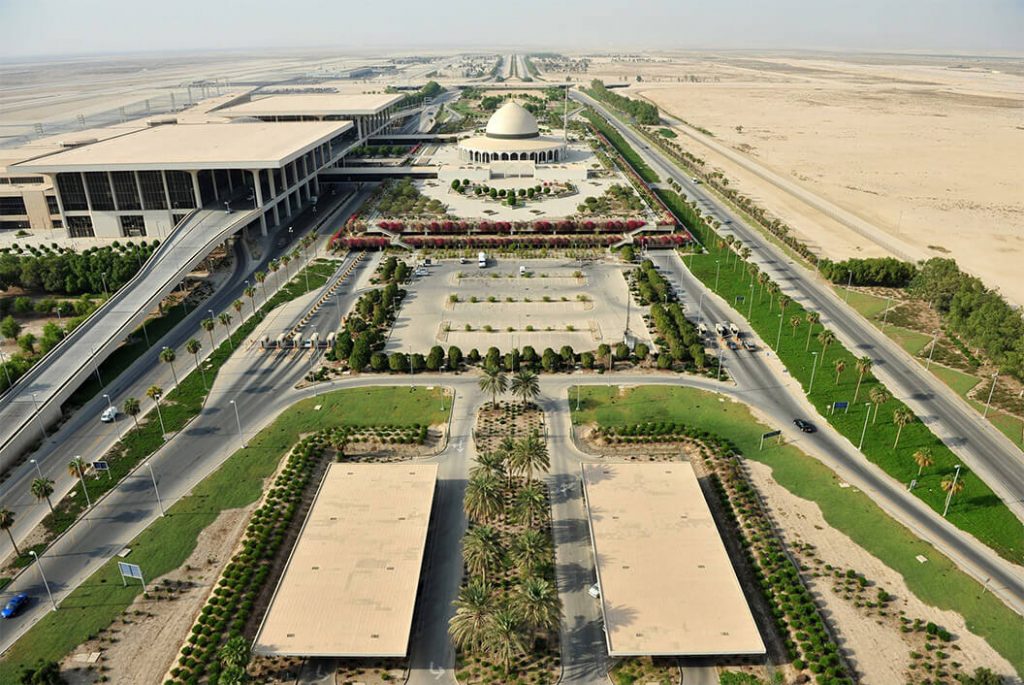
Location
The airport, in the Eastern Province of the country, is located between Qatif and Dammam, about 20 km (12 mi) away from Dammam.
The location of this airport provides unique role as it hosts the Kingdom’s shortest international flight to Bahrain as well as operating Saudi Arabia’s longest domestic flight between Dammam and Tabuk.
The airport is linked to populated areas by two major roads. The northern exit, which used to be the only one, links the airport with Qatif as a four-lane highway. The southern exit links the airport with Dammam as a six-lane highway to King Fahd Road which is now considered as the main road to the airport.
Abu Hadriyah Highway (Arabic: ابوحدريّة) serves as the airport’s eastern border while the Dammam-Riyadh Highway serves as a southern border. On the airport’s southern border, Saudi Aramco occupies an area of 250 km2 (97 sq mi), which is used for oil drilling and transportation facilities.
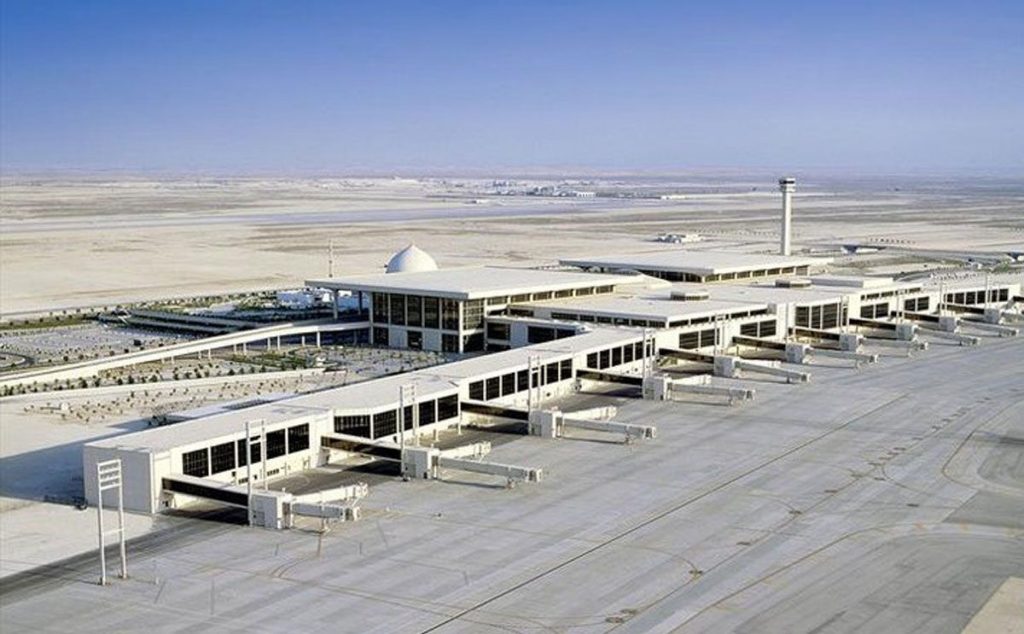
King Fahd International Airport History
Design started in 1976. The site master plan was created by architecture firm Yamasaki & Associates and Boeing Aerosystems International, and completed in 1977.
Construction began in 1983.
The airport’s basic infrastructure was complete by the end of 1990, which allowed the Allied forces engaged in the first Gulf War in early 1991 to use the field for the storage of military aircraft.
KFIA was the base used by all USAF A-10s (144), as well as the US Army’s 101st Airborne’s AH-64, CH-47, UH-60, and OH-58 helicopters during the Gulf War.
It was much more than a storage area. The US Army had many units there before the start of the war, as well as during redeployment from Iraq after.
the airport opened for commercial operations on 28 November 1999.
The largest airport in the world in terms of area
Several sources, such as the Guinness Book of World Records mention this airport as the largest in the world, with a total area of 780 square kilometers (larger than Bahrain).
The official website, however, publishes an actual utilized airport area of 3,675 hectares (9,080 acres), or 36.75 square kilometers. It does mention a total area of 77,600 hectares (192,000 acres), but that includes the whole property.
Terminals
A Sama Airlines Boeing 737 parked at the airport, bound for Medina. View from the departure lounge of the terminal.
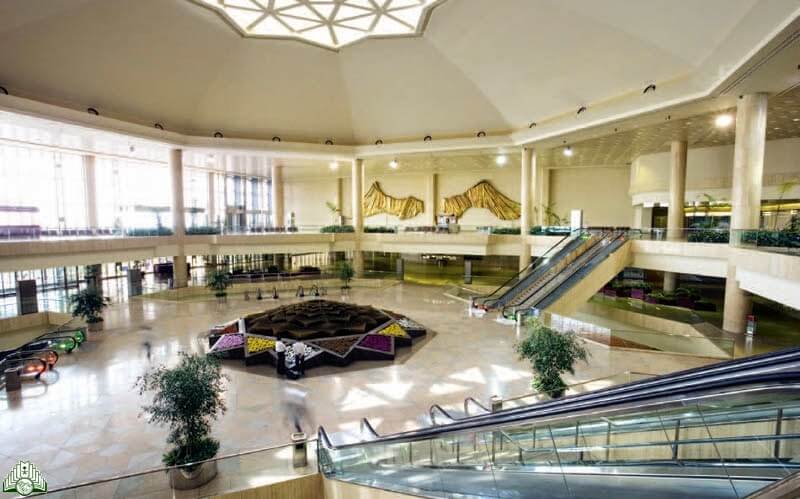
Inside the passenger terminal
The terminal has six stories, three of which are allocated for passenger processing. The third level is for arrivals, the sixth level is for departures, and the fourth level is for boarding. There are two partial levels: the mezzanine service level and the mezzanine level (which is the uppermost level).
The passenger terminal’s total area is 327,000 m2 (3,520,000 sq ft). Approximately 247,500 m2 (2,664,000 sq ft) were built in the first phase, in addition to 11 fixed passenger boarding bridges serving 15 gates out of an original design capacity of 31 fixed boarding bridges.
At the present time only 7 out of 11 boarding bridges can be used for international flight arrivals as the southern section of the terminal that hosts the remaining four gates is still unused making those gates unconnected to passport control and customs, however since domestic flights are entirely running from the operating northern section, all eleven boarding bridges can be used for domestic flights as well as the departures of international flights.
The terminal is equipped with several customer counters of which 66 were allocated to Saudia (now shared with flynas and SaudiGulf Airlines), 44 to foreign airlines, and the rest for customs and immigration.
The Mosque
The airport Mosque is built on the roof of the car park and in the middle of a landscaped area of 46,200 m² (497,292 ft²).
It has an architectural design that combines modern style with the old Islamic style (arches, domes, and other Islamic decorations and carvings on the doors, Mihrab, and Mimbar).
The Mosque accommodates two thousand worshipers, access to it can be easily gained from the passenger terminal through two enclosed, air-conditioned bridges equipped with moving belts, in addition to a third open bridge.
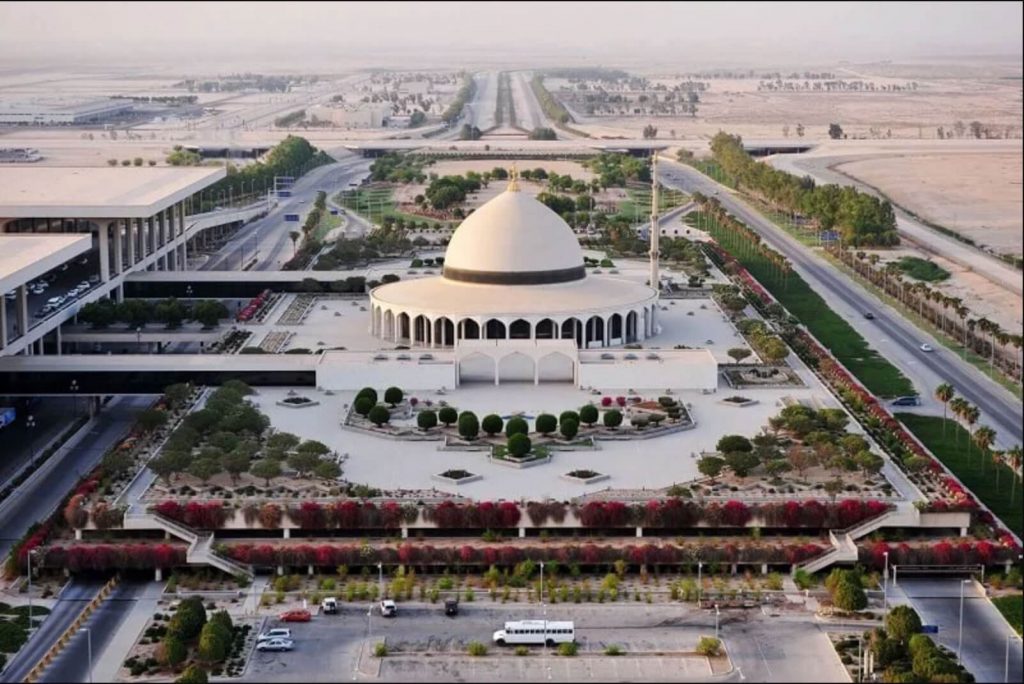
Hotel
A 250-room Hilton hotel is currently under construction and is expected to open late 2018 or early 2019.
The hotel will be linked to the airport terminal by a pedestrian bridge to facilitate easy access to and from the hotel.
Royal terminal
The Royal Terminal is reserved for the Saudi Royal Family, government personnel, and official guests.
The terminal was built on an area of 16,400 m2 (177,000 sq ft) and has four bridges linking the terminal and aircraft. It is luxuriously furnished and decorated, and includes extensively landscaped exteriors and grounds.
Despite its specialized purpose, the terminal is rarely used by the Royal Family, who generally prefers to utilize a similar special terminal at King Abdulaziz Air Base.
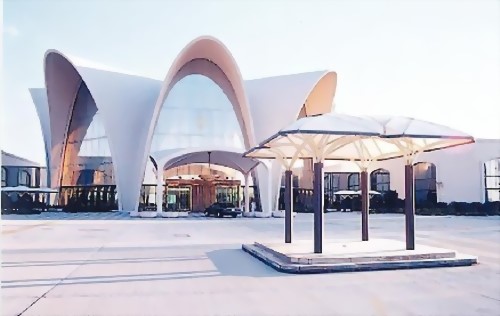
Airport infrastructure
Runways
The airport has two parallel runways with a length of 4,000 m (13,123 ft) each, in addition to taxiways parallel to the runways and a cross taxiway to connect the two runways.
A distance of 2,146 m (7,041 ft) separates the two runways to facilitate simultaneous takeoff and landing operations.
For more convenience and shorter taxiing durations, the east runway is usually used by Saudi Aramco while commercial airlines use the west one.
however situation changes if one of the runways is undergoing maintenance. Space has been set aside for the construction of a third parallel runway.
Cargo
The two-story air cargo building is constructed on an area of 39,500 m2 (425,000 sq ft) and has a capacity of 94,000 t (93,000 long tons; 104,000 short tons) of incoming and outgoing cargo.
The terminal’s design allows for transforming the operation system to a fully automatic system equipped with multi-level racks and a container stacking system.
When the air cargo facility becomes fully automatic, its capacity will be increased to 176,000 t (173,000 long tons; 194,000 short tons) per year.
Cargo village
To enhance its air cargo services, KFIA commenced construction of the new multi-model cargo village facility on 2012 which lasted for two years. The village was inaugurated on 6 April 2015.
The cargo village is over 500,000 m2 (5,400,000 sq ft). The village offers ease of shipping and cargo services and serves as a hub for global companies, directly serving the eastern province and the rest of the kingdom.
The village offers direct access to Saudi Arabia and eliminates the need to ship through neighboring countries.
Control tower
The control tower stands 85.5 m (281 ft) high, equivalent to the height of a 30-story building. The height allows visibility of all parts of the airport operations area.
Its total floor area is 7,960 m2 (85,700 sq ft), and it contains the following three main sections:
- Air traffic control level.
- Mezzanine level one, which accommodates support equipment for traffic control and communication.
- Mezzanine level two, allocated for a kitchen and toilets.
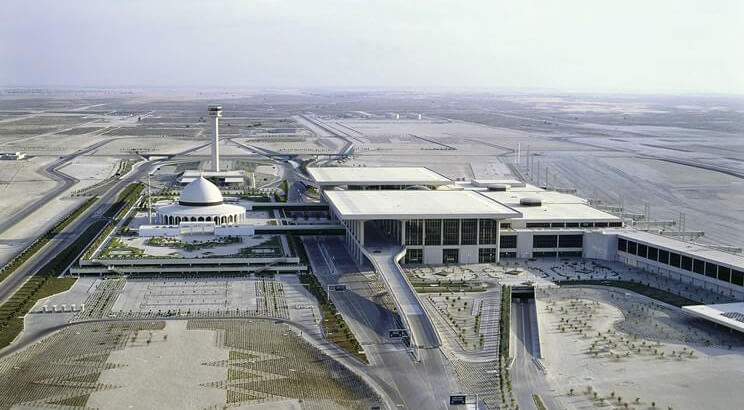
Car parking
The total area of the car park is 176,752 m2 (1,902,540 sq ft), distributed among three covered floors. The parking area accommodates 4,930 cars.
Two open parking areas are available beside the rental car parking area to accommodate additional cars. There are no ceiling rates.
Saudi Aramco facilities
The general aviation terminal on the east side of Dammam airport is being used exclusively by Saudi Aramco.
In addition, an advanced fleet of fuel tankers provides fuel services to all types of commercial aircraft. Saudi Aramco is responsible for supplying fuel and maintaining fuel installations.
These include six large tanks with a capacity of 40,000 barrels each, in addition to pumping equipment, filters, loading stations, and the distribution valve network.
Saudi Aramco operates regular flights for its personnel, which originate from Dammam to cover Haradh, Tanajib, Shaybah, Hawtah, Al Ahsa, Khurais, Riyadh, Jeddah, and Yanbu, in addition to some remote pump stations, using Boeing 737 and Embraer ERJ-170LR equipment.
Nursery and landscaping
King Fahd International Airport has its own plant nursery with a total area of 215,579 m2 (2,320,470 sq ft) which encompasses three green houses and 36,400 square metres (392,000 sq ft) of green fields.
The nursery supplies the airport gardens and planted areas with trees and plants.
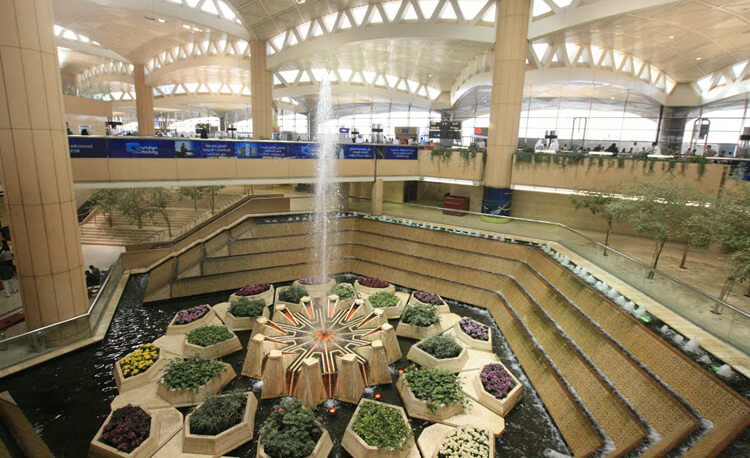
King Fahd International Airport Data
- Country
- Saudi Arabia
- Region
- Western Asia
- Status
- In use
- Official name
- مطار الملك فهد الدولي
- Location
- Dammam, Saudi Arabia
- Official website
- kfia.gov.sa
- Operator(s)
- Dammam Airports Company
- Cost
- About US $5 billion (in 1983)
- Began
- 1983
- Construction end
- 1990
- Opened
- Nov-28, 1999
- Airport type
- Public
- Airport code
- IATA: DMM, ICAO: OEDF
- Planing area
- 191754 acres / 776 km²
- Airport area
- 10527 acres / 42.6 km²
- All buildings area
- 1260 acres / 5100000 m²
- Main terminal area
- 73 acres / 293860 m²
- Runway length
- 2*4000 m
- Passenger traffic
- 11.6 million(2019)
- Freight volume
- 167,000 tons
- Takeoffs and landings
- 90134 sorties (2019)
- Elevation AMSL
- 72 ft / 22 m
View King Fahd International Airport on Google Satellite Map
Google satellite maps allow you to see building details more clearly, including natural landscapes such as mountains, rivers, deserts, sea and man-made engineering buildings.
If you are very interested in this engineering building, it is a good idea to click below Google Map icon. We will help you jump to the corresponding location of this building or engineering on Google satellite map.





























































